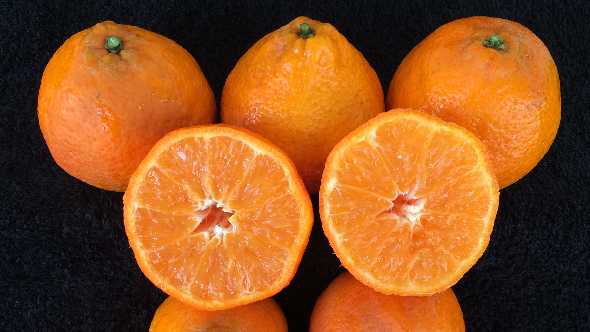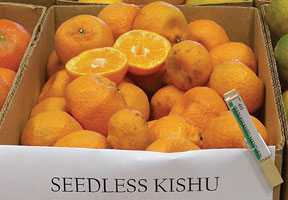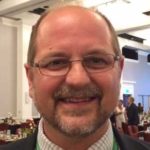Another Player Goes To Bat For Citrus Research
As scientists from multiple Florida-based research teams continue to explore progress in the development of new sweet oranges for processing, new fresh selections, and increased disease tolerance, New Varieties Development & Management Corp. (NVDMC) would like to introduce another intrastate citrus breeding program. This program is located in Gainesville and is under the exclusive direction of Dr. José Chaparro, associate professor in the University of Florida Horticultural Sciences Department. The breeding program is focused primarily on seedless, easy peel mandarins.

Photo courtesy of Peter Chaires
Though Dr. Chaparro’s program is in its infancy, it is already beginning to produce seedless easy peel mandarins for grower trials. The first fruits of his labors will be announced to industry this spring. The timing is right to offer a glimpse into this program and what it has in store for the Florida citrus nurseries and growers.
Dr. Chaparro is one of the few citrus horticulturists remaining in Gainesville. NVDMC began supporting his citrus breeding efforts in 2010. The North Central Florida location provides natural screening for cold tolerance, as cold susceptible seedlings would never make it past the first winter. However, recent opportunities to plant his new mandarin hybrids further south has enabled Dr. Chaparro to also evaluate new populations under heightened disease pressure and in climatic conditions more typical of commercial citrus production. The intent is to channel the more promising output from this program to the industry through the UF/IFAS FAST TRACK program. Ideally, candidate selections will be resistant to alternaria, scab, greasy spot, and ultimately HLB. To meet target qualifications, selections should be available over a range of maturity dates and have acceptable brix/acid ratios.
Numerous approaches have been used in the production of seedless mandarins. These include parthenocarpy in combination with male sterility (such as Satsuma), irradiation-based mutation (such as Tango and US Early Pride), and triploidy (such as Shasta Gold and the C4-15-19 seedless mandarin included in the first Suite of FAST TRACK).
Dr. Chaparro has elected to focus on the dominant seed sterility gene found in the Kishu. This gene conditions the abortion of seeds early in development leading to the production of seedless fruit. He has used Kishu pollen with numerous mainline seedy tangerine varieties, as well as his own line of breeding parents. As the process evolves, new breeding parents and combinations are continuously identified. This approach has worked well for this smaller-scale operation and has made it possible to accelerate selection and progress to second generation crosses. Everything in the Gainesville program is compact and efficient. Space is at a premium and resources are extremely limited. Every activity has a defined purpose and anticipated result.
Dr. Chaparro’s breeding efforts are expected to complement the work of the UF/IFAS Plant Improvement Team (CREC, Lake Alfred) and USDA-ARS (USHRL, Ft. Pierce).
How’s It Going?
Accelerate forward to the present. New crosses are still being developed, targeting the current and future needs of Florida’s growers and nurseries. However, more effort must now be expended on evaluating fruiting selections and an expansion of field trials. The first hybrids believed to segregate for HLB tolerance were planted at the Indian River Research and Education Center in Ft. Pierce. This should serve as an excellent screening and evaluation location for canker and greening.
The second round of mandarin hybrids should be ready to plant by late summer and are intended to combine greater tolerance, better fruit quality, early maturity, and easy peel characteristics. Additional projects are seeking to identify the genetic basis for enhanced tolerance in the hybrid populations to enable more focused crosses moving forward.
A Bonus Step
 Though Dr. Chaparro’s program is founded on the use of the dominant seed sterility gene of the seedless Kishu, some first generation crosses resulted in high-quality, seeded fruit.
Though Dr. Chaparro’s program is founded on the use of the dominant seed sterility gene of the seedless Kishu, some first generation crosses resulted in high-quality, seeded fruit.
One of the 2014-2015 projects supported by NVDMC calls for the identification of high-quality, easy peel, seeded selections for irradiation. It is hoped the irradiation process will induce a seedless mutation that retains all of its other original characteristics.
This is a somewhat resource intensive and time-consuming process, but it does present an opportunity to salvage a commercially valuable variety from something that would otherwise never become commercial. Budded trees from the irradiated budwood will be planted in Gainesville, raised to maturity, and screened for low-seeded or seedless fruit.
The Objective Remains The Same
It’s all about producing commercially valuable options for Florida nurseries and growers. Stay tuned for announcements of new mandarins entering the FAST TRACK program. While the research community focuses on developing and commercializing tools to combat HLB, the state’s breeders remain hard at work chasing the varietal traits and characteristics that have the potential to improve the competitive position of the grower. Time remains the critical element, but good things are happening.










